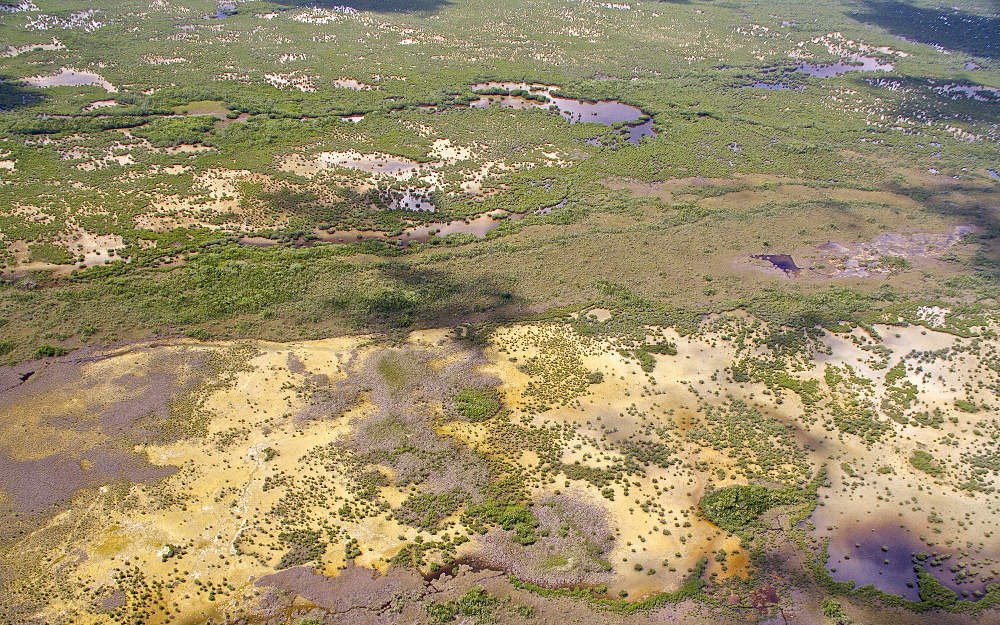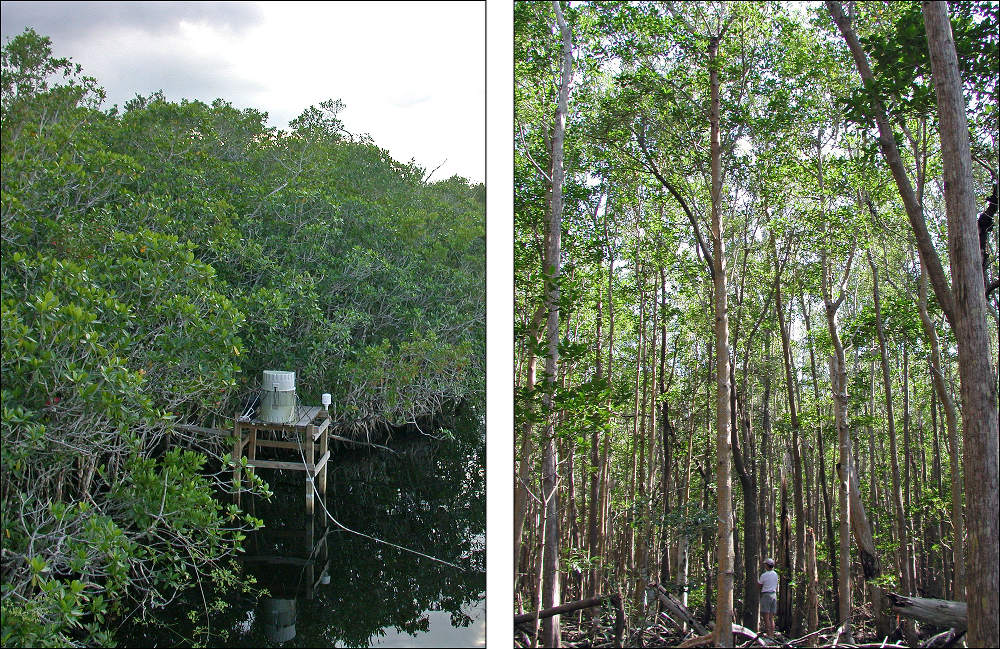FCE scientists discovered that, unlike in most coastal areas, the natural source of phosphorus (the nutrient that limits ecosystem productivity) for coastal Caribbean estuaries is seawater, not inland environments. This important finding has ramifications for both restoration and conservation and is informing decision-making in coastal areas.
- Key Findings
Contradicting classical estuary models, FCE LTER research demonstrated that marine nutrient supplies (rather than freshwater nutrient supplies) control coastal productivity gradients via daily tides, episodic storm surges, and hidden groundwater upwelling. Saltwater intrusion amplifies marine pulses by increasing connectivity to the sea and liberating phosphorus from limestone. Sea level projections based on long term data were refined, painting a better picture of how water quality will be affected by shifts in freshwater supply management (Dessu et al. 2018).

Ecotone interface between mangrove and sawgrass in lower Shark River Slough. Credit: Stephen Davis - Results

These two FCE research sites show the unexpected 'wedge of productivity' of mangrove forests in the Everglades. Marine sources of phosphorus enable mangrove forest canopy to reach 20m or more, as is seen in the image on the right, compared to the mangroves on the left that are growing several miles inland. Credit: Robert Twilley (image on the left) and Stephen Davis (image on the right)

Gradients of net ecosystem production differ between the two FCE drainages due to contrasting fresh (left, in blue) and marine (right, in green) water supplies of phosphorus (P) relative to nitrogen (N). Numbers refer to FCE sites (Fig. 1). SRS receives freshwater from inflow structures during the wet season, and marine water from daily tidal pulses and occasional hurricane-driven storm surges. It is a more productive, yet still oligotrophic, drainage where productivity increases toward the coast. TS/Ph is a smaller drainage with smaller seasonal freshwater inputs, and weak tidal pulses. It is a less-productive, oligotrophic drainage where productivity peaks in the ecotone where marine groundwater delivers P in the dry season. Water levels for marsh (SRS 1 and TS/Ph 1) and mangrove (SRS 4 and TS/Ph 6) sites are increasing due to increased rainfall and restored seasonal inflow pulses and the press of sea-level rise.
- Related Publications
Barr, J.G., V. Engel, J.D. Fuentes, J.C. Zieman, T.L. O'Halloran, T.J. Smith, G. Anderson. 2010. Controls on mangrove forest-atmosphere carbon dioxide exchanges in western Everglades National Park. Journal of Geophysical Research 115: G02020. DOI: 10.1029/2009JG001186
Castañeda-Moya, E., R.R. Twilley, V.H. Rivera-Monroy, K. Zhang, S.E. Davis, M.S. Ross. 2010. Sediment and Nutrient Deposition Associated with Hurricane Wilma in Mangroves of the Florida Coastal Everglades. Estuaries and Coasts 33(1): 45-58. DOI: 10.1007/s12237-009-9242-0
Childers, D.L., E.E. Gaiser, and L.A. Ogden. 2019. The Coastal Everglades: The Dynamics of Social-Ecological Transformation in the South Florida Landscape. Oxford University Press : New York, New York.
Childers, D.L., J.N. Boyer, S.E. Davis, C.J. Madden, D.T. Rudnick, F.H. Sklar. 2006. Relating precipitation and water management to nutrient concentration patterns in the oligotrophic "upside down" estuaries of the Florida Everglades. Limnology and Oceanography 51: 602-616.
Dessu, S.B., R.M. Price, T. Troxler, and J. Kominoski. 2018. Effects of sea-level rise and freshwater management on long-term water levels and water quality in the Florida Coastal Everglades. Journal of Environmental Management 211: 164-176. DOI: 10.1016/j.jenvman.2018.01.025
Price, R.M., P.K. Swart, and J.W. Fourqurean. 2006. Coastal groundwater discharge - an additional source of phosphorus for the oligotrophic wetlands of the Everglades. Hydrobiologia 569: 23-36.
Rivera-Monroy, V.H., R.R. Twilley, D. Bone, D.L. Childers, C. Coronado-Molina, I.C. Feller, J.A. Herrerra-Silviera, R. Jaffe, J.E. Mancera, E. Rejmankova, J.E. Salisbury. 2004. A conceptual framework to develop long-term ecological research and management objectives in the wider Caribbean Region. BioScience 54: 843-856.
For more information, contact Daniel Childers, John Kominoski, and Evelyn Gaiser.